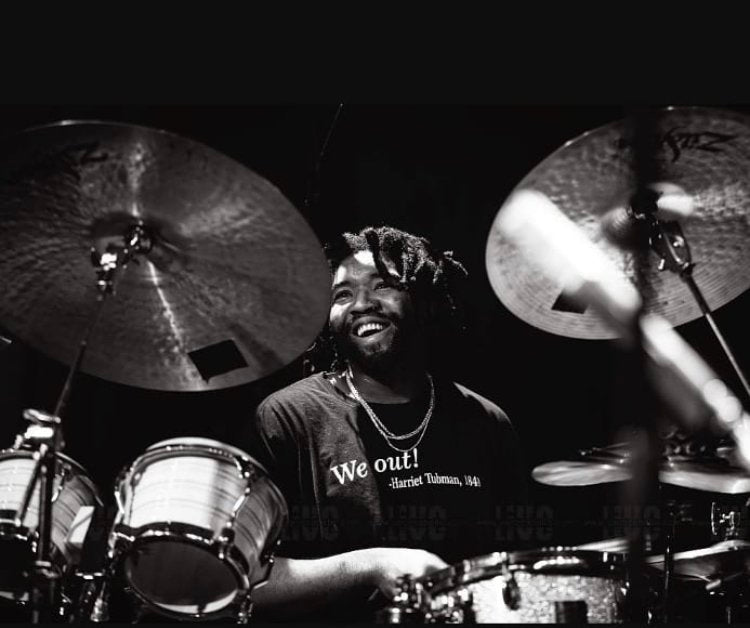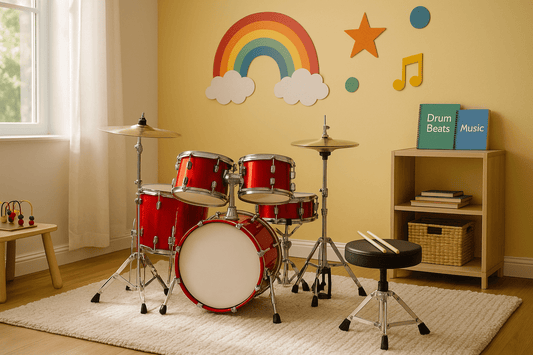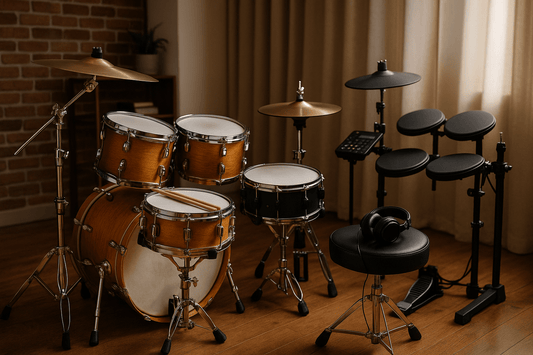Behind every great drummer is a solid foundation—literally. Whether you're playing your first groove or holding down a two-hour set, where and how you sit plays a massive role in your comfort, stamina, and precision. That’s why upgrading to an adjustable drum stool (also known as an adjustable drum throne) isn’t just a luxury—it’s a smart investment in your craft.
Unlike fixed-height stools, adjustable thrones let you dial in the perfect height, tilt, and seat angle for your body. The result? Better posture, less fatigue, more control over your kit, and ultimately, better drumming. In this article, we’ll break down the reasons why adjustable drum stools can make or break your performance—and highlight the best thrones to consider right now.
The Connection Between Comfort and Drumming Performance
How Seating Affects Endurance and Flow
Drumming is one of the most physically demanding musical arts. You're constantly using your arms, legs, and core in a rhythmically precise, repetitive way. Without the right seat setup, your body tires out faster than your creativity.
When your drum stool doesn’t support you properly—whether it's too low, too high, or just plain uncomfortable—your form starts to break down. You’ll shift more in your seat, stretch awkwardly to reach your pedals or cymbals, and put stress on your spine and hips. And guess what? That fatigue shows in your playing.
An adjustable drum throne allows you to set the perfect height for your body, ensuring you're always playing in a natural, efficient position. This minimizes energy waste, helps maintain focus, and lets you play longer and more consistently—without aching for a break.
Drumming Efficiency and Full-Body Engagement
A well-adjusted seat keeps your posture aligned and your limbs free to move without resistance. That alignment does wonders for your playing efficiency. You’re able to reach your toms, pedals, and cymbals with less effort, meaning faster transitions, tighter fills, and better timing.
But here’s where it gets better: proper seating engages your core. Instead of slouching, you’re sitting tall with balanced hips and a supported spine. This puts your body in a powerful, athletic position—essential for fast footwork, clean stick control, and those intense double-kick moments.
Comfortable, supportive seating lets your full body work together instead of fighting against itself. And when your body is in sync, your drumming is too.
What Makes an Adjustable Drum Stool Different?
Height Customization
This is the game-changer. Fixed-height thrones force your body to adapt to the seat—not the other way around. That can lead to awkward angles and discomfort. An adjustable drum stool, however, lets you choose a height that fits your legs, arm length, and playing style.
Most stools offer a range of 43 to 65 cm in height. You want your thighs to angle slightly downward, with your feet flat on the pedals and your hips above your knees. With this setup, your spine stays aligned and your lower back doesn't bear unnecessary pressure.
Some thrones feature hydraulic lift systems for fast, on-the-fly changes. Others use threaded spindle posts for secure, mechanical adjustment. Both work well—it just depends on how often you like to tweak your setup.
Swivel and Tilt Features
Beyond height, many adjustable stools include tilt and swivel capabilities. A swiveling seat is essential for moving across your kit fluidly without twisting your spine. Whether you're reaching for a floor tom or hi-hat, rotation keeps your body aligned.
Tilt features help you fine-tune the angle of the seat. Tilting slightly forward can help open up your hips, support your lower back, and engage your core. For players with tight hips or low back tension, this subtle shift can bring huge relief.
Look for stools that allow you to lock or loosen the tilt to suit your preference. These small adjustments can mean the difference between a throne that supports you—and one that sabotages your posture.
Ergonomic Seat Design and Contouring
Adjustable drum stools often come with ergonomically shaped seats. These are typically saddle-style or contoured to support your legs and reduce pressure on your tailbone. The design promotes better circulation and reduces numbness during long sets.
Some advanced models even feature split-seat designs or spinal relief channels, which minimize stress along your spine and improve comfort dramatically. These might seem like luxury features, but for serious players, they make all the difference in endurance and injury prevention.
Thrones with memory foam or multi-layer padding provide a balance of softness and support, letting you sit longer without going numb or sinking into the seat. That’s why many pro drummers swear by their high-end thrones—it’s not just the gear, it’s the way it feels under pressure.
Benefits of an Adjustable Drum Throne
Improved Posture and Spinal Health
Drummers often spend hours hunched over their kits without realizing the toll it takes on their bodies. A poorly positioned seat—especially one that’s the wrong height—can lead to rounded shoulders, slouched lower backs, and misaligned hips. Over time, this not only affects your playing but can cause chronic pain, muscle tightness, and even injury.
An adjustable drum stool fixes that by letting you fine-tune your posture. With the right seat height and angle, your spine stays in a neutral, upright position. This alignment reduces pressure on your lumbar spine and helps engage your core muscles—so you’re not just sitting; you’re actively supporting your body.
Drummers with existing back problems especially benefit from adjustable thrones with ergonomic shaping or backrest support. These features provide relief, reinforce posture, and allow you to play longer with less strain. A small adjustment in seat angle or height can eliminate hours of discomfort. It’s that powerful.
Enhanced Foot Control and Reach
Your drum stool directly affects your feet—something many players overlook. If your stool is too low, your knees rise, making it harder to operate your bass drum or hi-hat pedals. If it’s too high, your legs overextend, reducing control and speed.
When your throne is adjusted just right, your legs are in a natural downward angle, letting your feet rest on the pedals with minimal tension. This positioning maximizes control and reduces fatigue, especially during fast footwork or complex double kick patterns.
And it doesn’t stop at your feet. Your upper body benefits too. The proper height lets you position your snare, toms, and cymbals within easy reach, eliminating awkward stretching or slouching mid-play. That means faster fills, smoother transitions, and less physical strain overall.
Reduced Fatigue During Long Sessions
We’ve all been there: halfway through a session and your lower back starts to ache, your legs feel heavy, and your focus begins to slip. Fatigue sets in fast when your seat doesn’t support your body the right way.
An adjustable throne changes that. With better alignment and weight distribution, your muscles stay relaxed but engaged, which delays fatigue and keeps your mind sharp. You’ll find it easier to maintain energy and accuracy throughout the entire session.
Many adjustable stools also include thicker padding or contoured seats, which eliminate pressure points and reduce numbness or tingling in your legs. This comfort boost alone makes a huge difference—especially during long practices, studio sessions, or multi-set gigs.
Choosing the Right Adjustable Drum Stool
Spindle vs. Hydraulic Mechanisms
Both systems have their perks—but knowing which one suits your playing style can help you make the right decision.
-
Spindle (Threaded): These thrones adjust via a rotating threaded post. They’re extremely durable, rock-solid, and preferred by touring drummers who want consistency. The downside? They take a little longer to adjust.
-
Hydraulic (Gas Lift): These use a pneumatic system, like an office chair. They adjust quickly with a lever, which is super convenient if you tweak your setup often. However, they’re slightly more prone to wear over time and may lose pressure after years of use.
If you’re after maximum reliability, go spindle. If you want speed and ease, go hydraulic.
Round vs. Saddle Seats
Both seat shapes have their fans—and your choice often comes down to personal preference and comfort needs.
-
Round Seats: Traditional and simple. They allow more mobility and are generally preferred by players who move around the kit a lot. However, they offer less thigh support and can be uncomfortable for long sessions if not well-padded.
-
Saddle Seats: Shaped like a motorcycle seat, they provide better hip and leg support and promote better posture. Many ergonomic thrones use this shape because it helps with spinal alignment and reduces fatigue.
If you prioritize mobility, go round. If you want support and posture alignment, go saddle.
Backrest Options for Extra Support
Backrests aren’t just for sitting back and relaxing—they’re posture tools. A good adjustable drum throne with a backrest provides lumbar support during long sessions and helps reinforce an upright position. It’s especially helpful for drummers with back issues or those doing long recording takes.
Some thrones come with built-in or removable backrests, giving you flexibility based on your needs. Others allow you to purchase and add a backrest later. Either way, having the option can be a game-changer—especially if you play seated for hours at a time.
Top Adjustable Drum Thrones for All Levels
Tempo Gear T32 Premium Adjustable Drum Stool
Built for comfort, stability, and portability, the Tempo Gear T32 offers a 32cm-wide ergonomic seat with 7cm of high-density foam. Its gas-lift hydraulic system adjusts smoothly between 43–65cm, making it ideal for drummers of various heights. The sturdy, double-braced chrome legs provide excellent support while remaining lightweight and easy to transport.
-
Best For: Intermediate to advanced players
-
Seat Type: Wide round padded
-
Adjustment: Hydraulic
-
Why It Stands Out: Exceptional value with pro-level comfort and adjustability.
Tama 1st Chair Glide Rider
This throne is a favorite among professionals for its hybrid seat (a cross between saddle and round), ultra-stable base, and smooth height adjustments via its spindle mechanism. It also features seat lock and memory lock systems, so your ideal setup never shifts mid-performance.
-
Best For: Touring drummers, technical players
-
Seat Type: Hybrid ergonomic
-
Adjustment: Spindle
-
Why It Stands Out: Superior ergonomics, flawless build quality.
DW 5000 Series Tractor Seat
If you're after heavy-duty support, the DW 5000 series throne delivers. With its large tractor-style seat, solid steel construction, and double-braced legs, it’s a throne built to withstand intense play. The foam padding is firm yet comfortable for long sessions.
-
Best For: Rock, metal, and heavy-hitting drummers
-
Seat Type: Tractor (saddle)
-
Adjustment: Spindle
-
Why It Stands Out: Built like a tank—ultra-reliable and pro-grade.
Roc-N-Soc Nitro Throne
Loved for its plush saddle seat and Nitro gas-lift, the Roc-N-Soc is a go-to for comfort-focused drummers. It’s also compatible with an optional backrest, making it a top pick for long gigs or rehearsals.
-
Best For: Long sessions, back support seekers
-
Seat Type: Saddle
-
Adjustment: Hydraulic
-
Why It Stands Out: Cloud-like comfort with serious support.
Ahead Spinal G Throne
A throne designed with spinal health in mind, the Spinal G features a split seat to relieve pressure on the tailbone and spine. It’s a favorite among players dealing with chronic back pain and is engineered for ergonomic perfection.
-
Best For: Drummers with back problems
-
Seat Type: Split saddle
-
Adjustment: Spindle
-
Why It Stands Out: Medical-grade comfort and innovative design.
How to Set Up an Adjustable Drum Stool Properly
Finding the Right Height for Your Body
The first step is adjusting the stool height so that your thighs are angled slightly downward, with knees just below hip level. This reduces hip tension and engages your core while promoting good posture.
To set it up:
-
Sit on the stool with your feet on the pedals.
-
Adjust until your hips are about 1–2 inches above your knees.
-
Ensure your shoulders are relaxed, not hunched.
This position gives you optimal control over your kit without slouching or overreaching.
Adjusting for Optimal Foot and Hand Positioning
Once your height is set:
-
Make sure your feet rest flat on the pedals without needing to stretch.
-
Your snare should sit just below waist level for easy reach.
-
Toms and cymbals should be within natural reach to avoid leaning or twisting.
Your stool should be centered behind your kit, and your entire upper body should feel relaxed, not strained.
Locking in Your Ideal Configuration
Most adjustable thrones come with memory locks, tension rods, or clamps. Once you’ve dialed in your perfect height and angle:
-
Lock it down.
-
Mark the leg positions on your drum rug or floor with tape.
-
If your throne swivels, make sure the seat mount is tight and doesn’t wiggle unnecessarily.
This consistency ensures your setup feels the same every time you sit down—boosting muscle memory and improving performance.
Common Mistakes Drummers Make with Drum Stools
Ignoring Seat Height and Angle
One of the biggest mistakes drummers make is accepting the default height or not adjusting the throne at all. This leads to posture issues, poor foot control, and faster fatigue.
Take the time to test different heights and angles. Even small changes can drastically improve how you play—and how you feel after playing.
Overlooking Stability and Leg Positioning
A stool that shifts or wobbles mid-performance is more than annoying—it’s dangerous. Make sure your legs are wide enough for stability, and all rubber feet are firmly planted. Never sit with your knees up or feet floating—your pedals should support your natural leg motion.
Skipping Regular Adjustments or Maintenance
As your skills evolve, your body and technique do too. That means your seat height might need to change over time. Don’t assume your initial setup will work forever. Re-evaluate regularly, and always check for loose hardware or worn seat foam.
Why Every Drummer Should Upgrade to an Adjustable Throne
From Practice to Performance Gains
An adjustable drum stool doesn't just help with comfort—it improves your playing. You gain consistency, better posture, improved pedal control, and more confidence behind the kit. Your practice becomes more productive, and your performances feel smoother and stronger.
Long-Term Comfort and Injury Prevention
Sitting improperly for long hours puts stress on your lower back, shoulders, and legs. Adjustable thrones help eliminate these risks by offering a personalized, ergonomic seating experience that supports your body during every beat.
Making the Investment Worth It
Sure, an adjustable throne might cost more than a basic seat—but the benefits are long-term. You won’t need to replace it every year, and your body will thank you in both comfort and performance. It’s one of the smartest upgrades a drummer can make.
Conclusion
If you're still using a fixed or budget seat, now's the time to upgrade. An adjustable drum stool isn’t just a convenience—it’s an essential piece of gear that boosts your posture, protects your body, and elevates your playing. Whether you're a hobbyist, teacher, studio player, or road warrior, investing in the right throne gives you the comfort and support to perform at your best, every time you sit down.
FAQs
1. Is an adjustable drum stool better than a fixed one?
Yes. Adjustable stools offer customized height and seat positioning, which improves posture, comfort, and control—benefits you won’t get from a fixed-height seat.
2. How high should my drum throne be?
Your hips should be slightly higher than your knees, with your thighs angled downward and feet flat on the pedals. Most drummers find their ideal height between 45–60 cm.
3. Can an adjustable drum throne help with back pain?
Absolutely. Adjustable thrones allow for ergonomic positioning that supports spinal alignment, reduces lumbar strain, and promotes better posture—especially with saddle seats or backrests.
4. Do pros use adjustable stools too?
Yes. Most professional drummers use high-end adjustable thrones because they offer consistency, stability, and comfort during long sessions and intense performances.
5. What’s the best adjustable drum stool under $150?
The Tempo Gear T32 is one of the best options under $150. It offers ergonomic design, thick padding, and a smooth hydraulic adjustment system at a great price.




